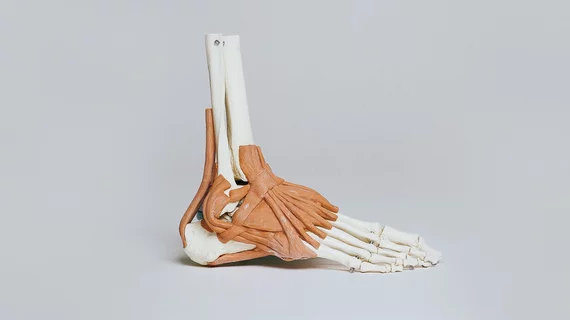Many clinicians flouting X-ray-first guidelines for ankle imaging
Established clinical guidelines hold that patients presenting with ankle issues should not receive advanced imaging ahead of standard radiography. New research shows a substantial proportion of ordering clinicians sending these patients straight to MRI anyway.
In the study, only 68% of around 4,200 ankle patients imaged with MR over a nine-year period at a major academic medical center had been X-rayed ahead of the MRI within the three prior months.
The ratio was better for patients who had X-rays within six months prior to the advanced imaging—77%—but, either way, a majority of ordering specialties had relatively low rates of guideline adherence.
Least likely to comply within the six-month timeframe were primary care providers (73%), sports medicine doctors (68%) and podiatrists (64%).
By contrast, the highest radiography-first rates were achieved by emergency medicine and inpatient providers (89%), followed by orthopedic surgeons (86%).
The study was conducted by radiologists at UC Davis Medical Center and is posted online in Skeletal Radiology [1].
Kristopher de Ga, MD, and co-authors also found the clinical indications most likely to spur MRI-first imaging were abnormalities of the Achilles tendon and plantar fascia.
The team notes X-ray-first guidelines are similarly promoted by the American College of Radiology, the Choosing Wisely campaign, the Ottawa Ankle Rule and the Pediatric Orthopedic Society of North America.
“The rationale is that radiographs may provide all the diagnostic imaging information needed for appropriate management, potentially eliminating the need for more costly subsequent imaging,” de Ga and colleagues point out. “MRI may be helpful in a variety of circumstances, but generally only after initial radiographs are performed.”
The authors suspect the high rate of compliance among emergency and inpatient providers, a combined 89%, owes to the typically low MRI access in those settings at their institution, combined with the hospital’s used of a standardized trauma workflow that starts with radiography.
More:
When utilized appropriately, ankle MRI can make a dramatic impact on patient diagnosis and management. However, we emphasize that radiographs remain the first recommended imaging modality in the evaluation of acute and chronic ankle symptoms as many diagnoses can be made with radiographs alone. In instances where an MRI is clinically warranted regardless of radiographic findings (such as primarily soft tissue injury), we maintain that radiographs may still assist in the interpretation of these MRIs.”
The journal has posted the study in full for free.
More Coverage of Advanced Imaging Guidance:
VIDEO: Cardiac CT training requirements for radiologists and technologists
6 categories of contrast CT prove ripe for revisiting during supply shortage
Updated lung cancer screening guidelines could spell 54% surge in LDCT imaging eligibility
FDA issues new guidance on appealing decisions that adversely impact mammography accreditation
ACR releases new mammography guidance to aid in ongoing COVID-19 resurgence
Reference:
- Kristopher de Ga, Dylan Noblett and Cyrus Bateni, “Ankle MRI and preceding radiographs: an evaluation of physician ordering practices.” Skeletal Radiology, June 6, 2022. DOI: https://doi.org/10.1007/s00256-022-04084-8

